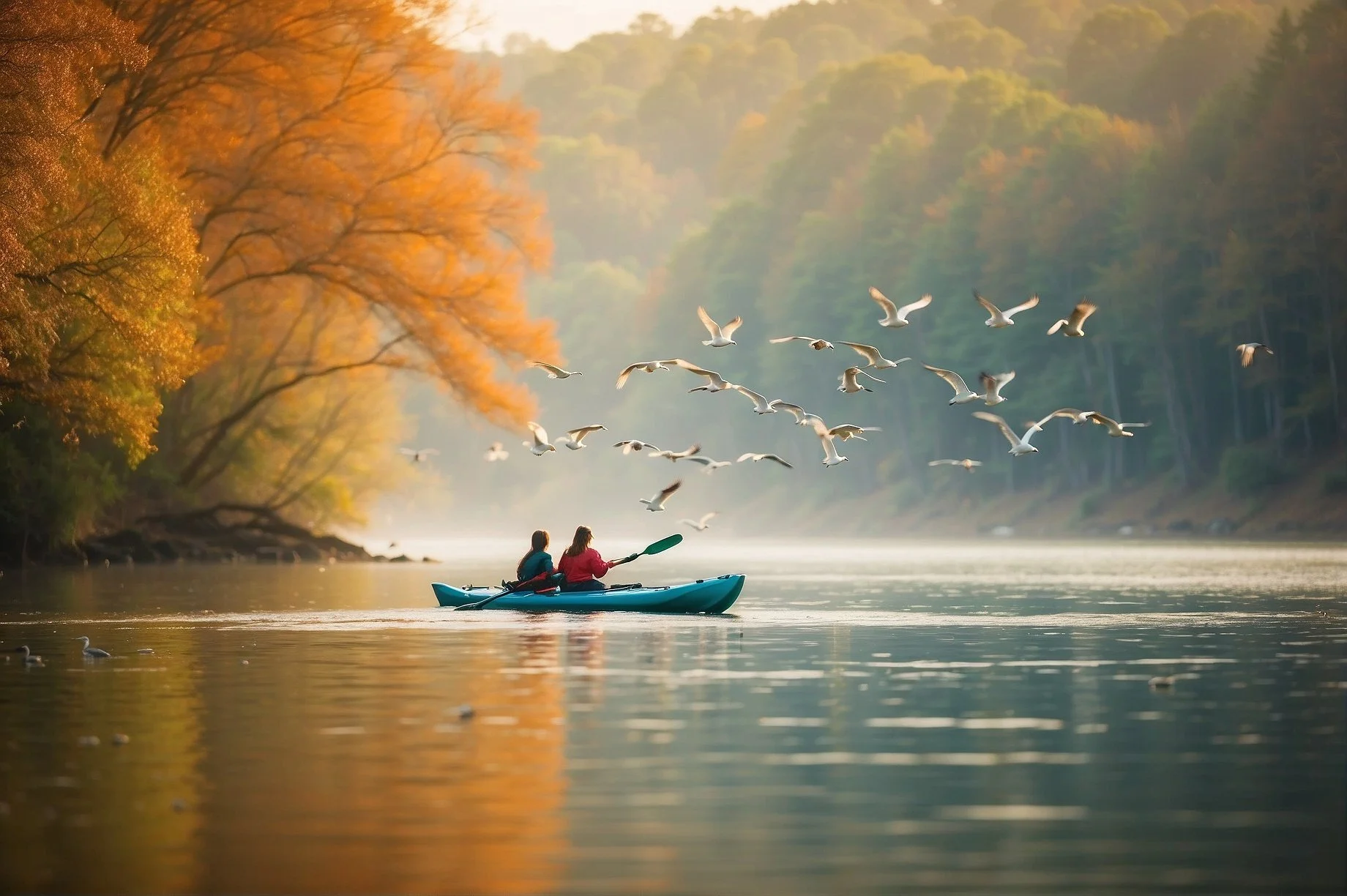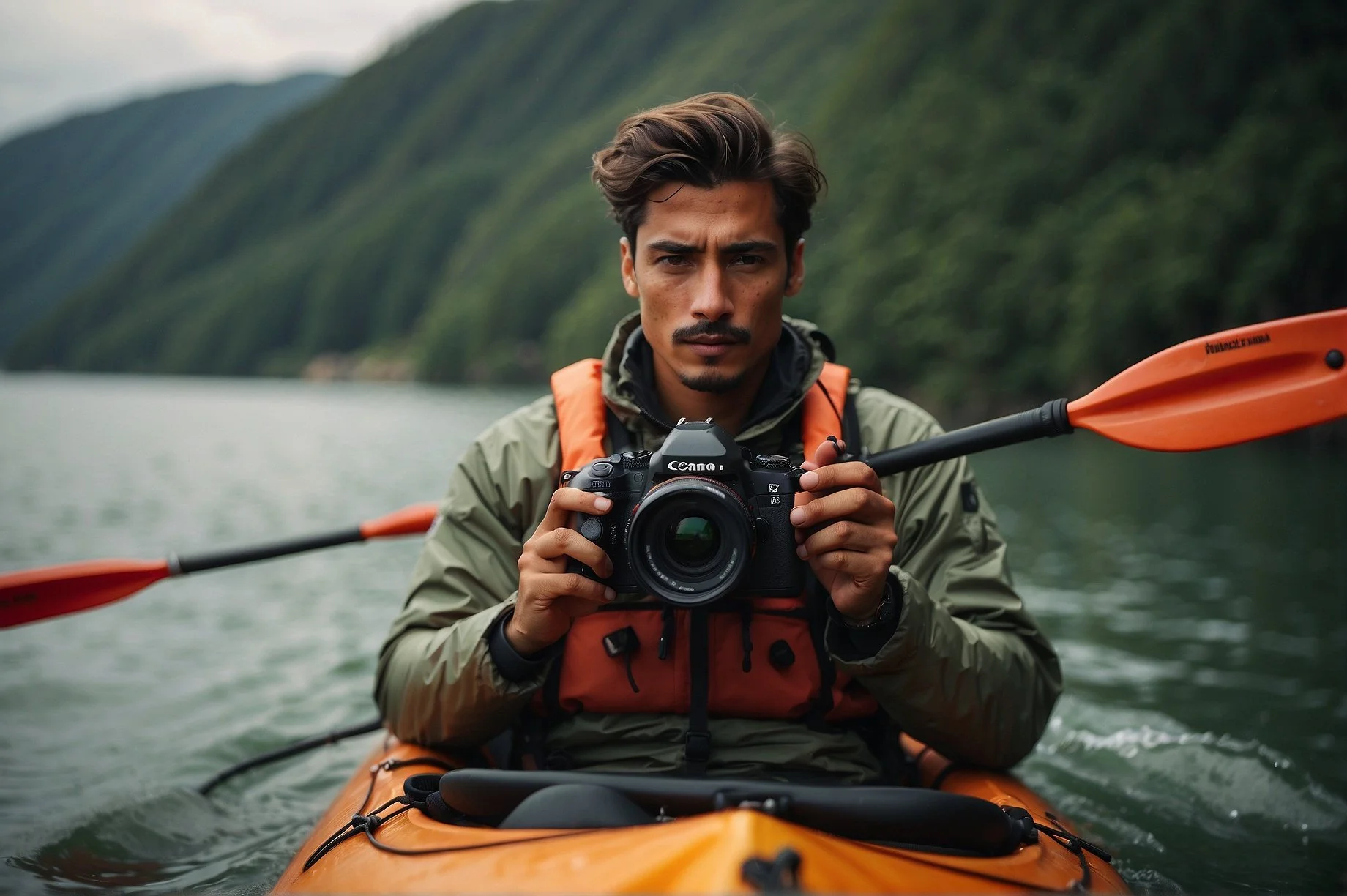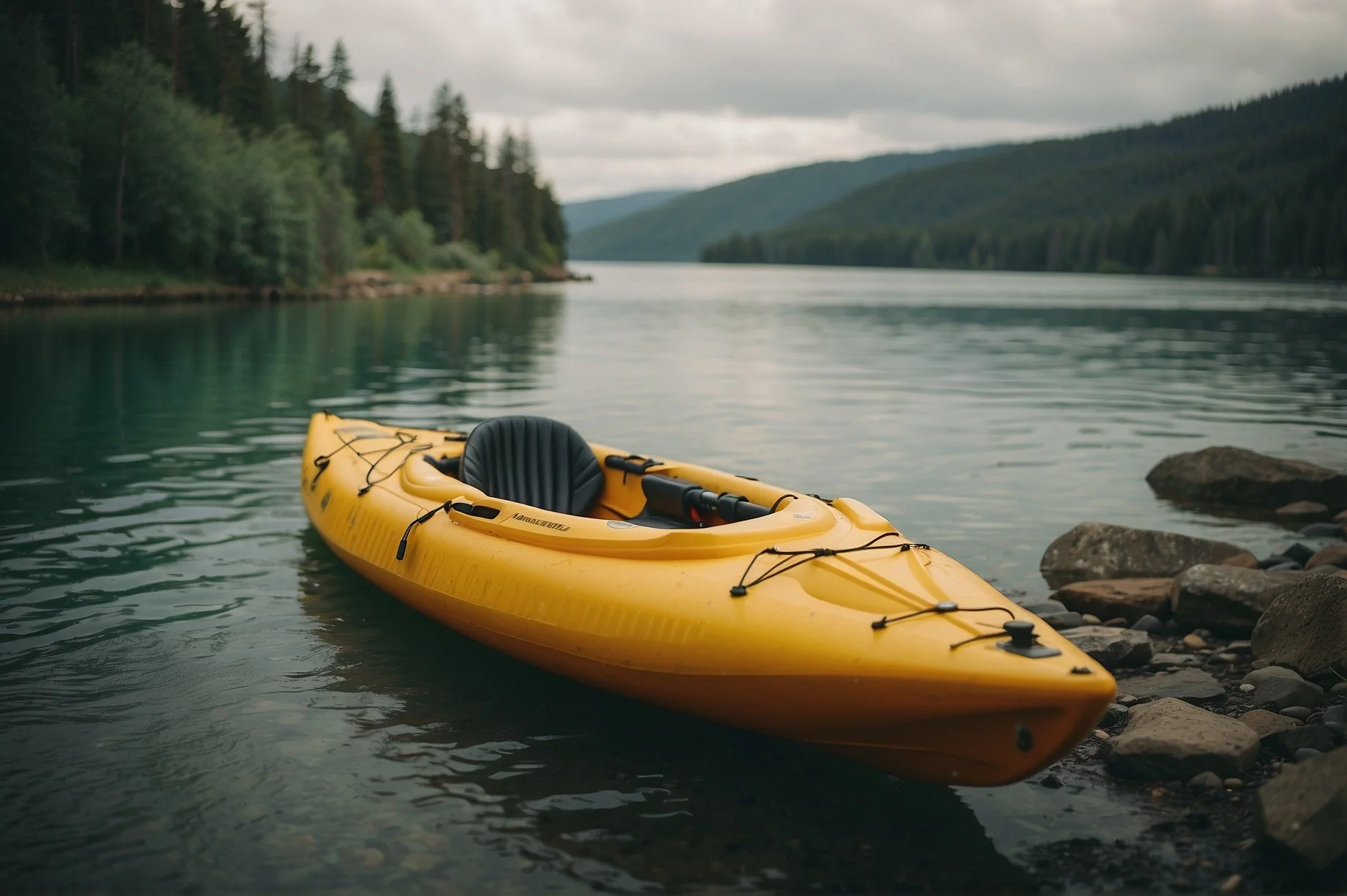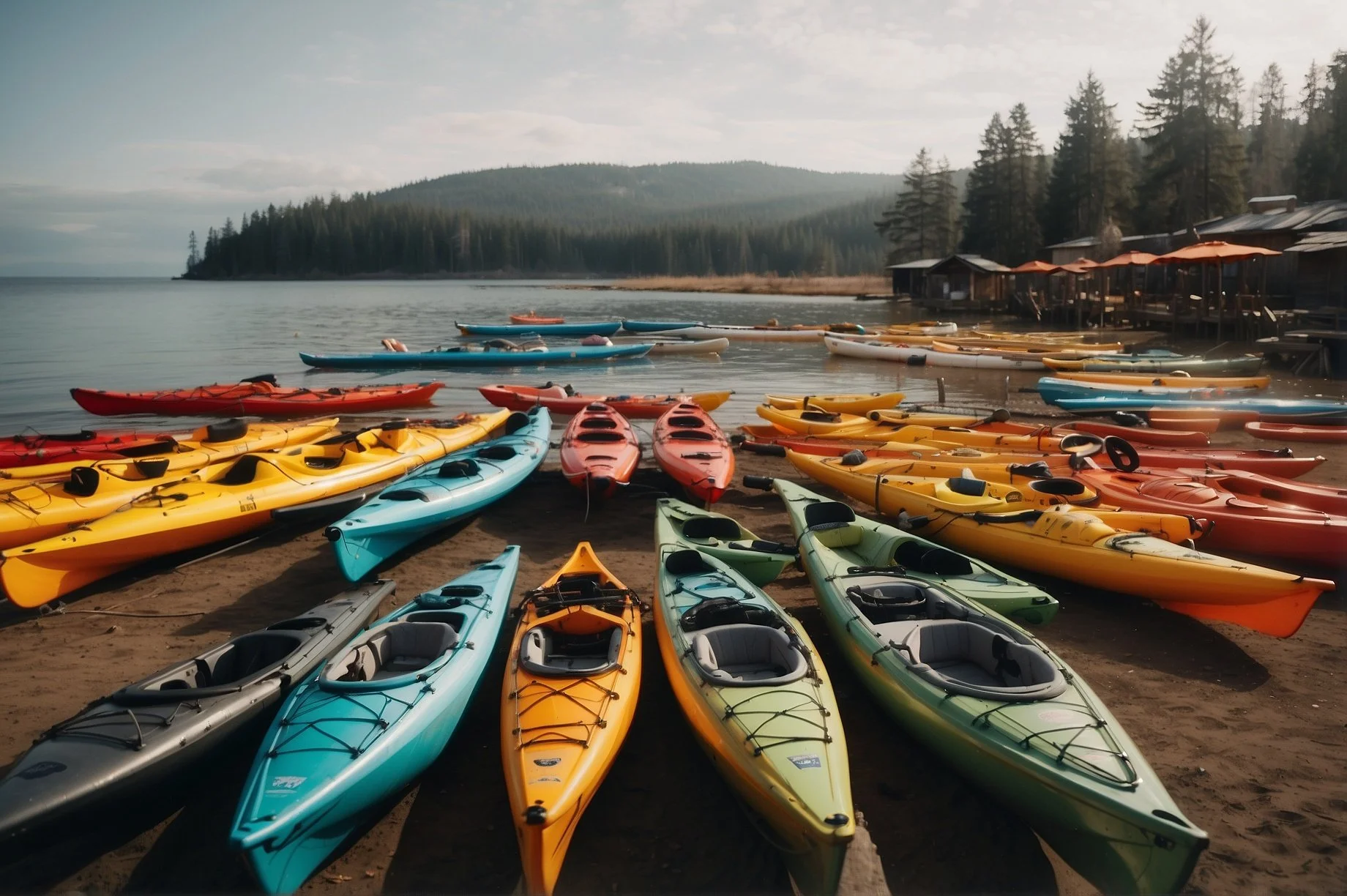Kayak Bird Watching: Tips for Photography and Kayak Selection
No time to read? Quickly get where you are going.
As an Amazon Associate, we earn from qualifying purchases. By purchasing through these links, you can support our efforts to bring you more birdwatching tips and recommendations.
INTEX Challenger Inflatable Kayak Series - $130-170 jump to item
INTEX Excursion Pro Inflatable Kayak Series - $270-500 jump to item
Intex 68307EP Explorer K2 Inflatable Kayak Set - $180-200 jump to item
Sevylor QuickPak K5 1-Person Inflatable Kayak - $109-409 jump to item
Bestway Hydro-Force- $122-160 jump to item
INTEX Excursion Inflatable Boat Series - $140-275 jump to item
BKC FK184 9' Single Sit On Top Fishing Kayak - $1000-1300 jump to item
Lifetime 90479 Youth 6 Feet Wave Kayak - $148-160 jump to item
Bird watching is a captivating hobby that allows us to connect with nature and appreciate the beauty of our feathered friends. If you want to take your bird-watching experience to the next level, why not try it from a kayak?
Kayak bird watching offers a unique vantage point, allowing you to get closer to birds while immersing yourself in their natural habitat. In this blog post, we'll explore the best practices for bird watching from a kayak, share tips for capturing great bird photos, discuss the different types of kayaks, recommend models for bird watching, and provide essential safety measures.
Some of the best kayaks for photography, wildlife photography, nature photography, and birding photography are waiting to be discovered by you!
Let's embark on this exciting adventure!
Best Practices for Bird Watching from a Kayak
To make the most of your kayak bird-watching experience, it's essential to follow some best practices:
Choosing the Right Time and Location
Research the best times and locations for bird watching in your area. Birds are often more active during early morning and late evening hours.
The coastal areas and wetlands are ideal habitats for various bird species, making them excellent locations for kayak bird watching.
National parks and wildlife sanctuaries also offer excellent opportunities to spot rare and migratory birds.
Respectful Behavior and Minimizing Disturbance
Keep a safe distance from the birds to avoid causing stress or interrupting their activities. Avoid loud noises or sudden movements that could startle them.
Refrain from feeding or touching the birds, as this can disrupt their natural behavior and potentially harm them.
Binoculars and Field Guides
Invest in a good pair of binoculars to enhance your bird-watching experience. Carry a field guide or a bird identification app to help you identify different species.
Take notes or use a bird-watching journal to record your observations and keep track of the birds you've seen. find a good pair here!
Wearing the Right Gear
Wearing appropriate attire can significantly improve your bird-watching experience. Opt for comfortable, durable clothing suitable for the weather conditions. Choose colors that blend well with your surroundings, like earth tones or greens, as bright colors can startle birds and make them harder to observe.
Waterproof clothing and boots keep you dry, while a wide-brimmed hat and sunglasses protect you from sun glare.
Lastly, bring a light, waterproof jacket or poncho in case of unexpected showers. You may be out for an extended period and want to be prepared!
Tips for Capturing Great Bird Photos on a Kayak
Photographing birds from a kayak can be challenging yet rewarding. Here are some tips to help you capture stunning bird photos:
Camera Settings and Equipment Recommendations:
Experiment with different camera settings to find the best ones for bird photography. Use a telephoto lens to zoom in on the birds without disturbing them.
A tripod or monopod can also help stabilize your camera for sharper images.
Positioning Your Kayak:
Approach the birds slowly and quietly to avoid startling them. Position your kayak at a safe distance to avoid interfering with their natural behavior.
Take advantage of natural cover, like reeds or branches, to blend in with your surroundings and get closer to the birds.
Generally speaking, kayaking is very relaxing and gives excellent views of animals. When shooting larger birds like a heron or ostrich, the natural shooting position is near the eyes of the subject. The shot is perfect.
Timing and Lighting:
The best time to photograph birds is during the golden hour, which occurs an hour after sunrise and an hour before sunset. The lighting during this time is soft and warm, creating beautiful images. Up and early or late at night to keep that good light!
Avoid harsh midday light, which can create unflattering shadows on your subject, especially when discussing wildlife photography and bird photography. The best lighting and activity are listed above.
Techniques for Steady Shots on a Kayak
Use image stabilization features or a tripod to stabilize your camera and reduce camera shake. Practice keeping your kayak steady while taking photos. You may need a tripod setup to keep the camera continued to get those sharp images.
Mastering the shooting angle from your kayak provides an excellent perspective for bird photography. The seated position in the kayak makes for a stable platform, ensuring your camera stays steady even with a long lens.
Remember to have enough space on your memory card to capture that nice shot, as you wouldn't want to run out of memory at a crucial moment.
Framing the subject appropriately is vital to a compelling composition, and choosing the right moment to shoot can make the difference between a good photo and a great one.
Keep the camera steady as possible by using a tripod and timing your shots with the waves or water disturbances. Some wildlife photographers use a higher shutter speed, which may need to ensure you are extra stable. Find help with optical image stabilization here!
The Differences in Kayaks
Choosing the right kayak is crucial for bird-watching from a kayak. Here are the two main types to consider:
Sit on Top Kayak
Sit-on-top kayaks are stable, easy to maneuver, and offer ample space to store your gear. They are great for beginners and provide a comfortable platform for bird-watching. They are the most stable kayak, making them the perfect photography kayak.
Sit In Kayak
Sit-in kayaks offer better protection from the elements and can handle rougher waters. They also have a lower profile, making them easier to maneuver in tight spaces. Some have the pedal drive, making a pedal-drive kayak easier to handle.
However, they may not be as stable as sit-on-top kayaks for bird photography.
Inflatable Kayak
Inflatable kayaks are lightweight, portable, and ideal for bird-watching in remote or hard-to-reach areas.
They offer easy storage and transportation while maintaining stability.
Recommended Kayaks for Bird Watching
To make your decision easier, here are some top kayak models for bird watching:
INTEX Challenger Inflatable Kayak Series
The INTEX Challenger Inflatable Kayak Series combines durability and comfort in a compact package. This series is known for its rugged vinyl construction and inflatable I-beam floors that provide stability.
Pros: Lightweight, stable, affordable, and easy to inflate and deflate.
Cons: Some users report durability issues over time.
Best For: Budget-conscious bird watchers seeking a portable option.
INTEX Excursion Pro Inflatable Kayak Series
The INTEX Excursion Pro Inflatable Kayak is a high-end model known for its excellent stability, spacious design, and premium PVC construction. It has two adjustable seats, a carry bag, and a repair patch.
Pros: High-end features, comfortable seating, and excellent stability.
Cons: Higher price point.
Best For: Bird watchers seeking a comfortable, high-quality inflatable kayak.
Intex 68307EP Explorer K2 Inflatable Kayak Set
The Intex 68307EP Explorer K2 Inflatable Kayak Set is known for its bright yellow color for better visibility and adjustable inflatable seats. It is suitable for two people and has a maximum capacity of 400 pounds—a fantastic choice for folks who need enough room.
Pros: Obvious design, adjustable seats, and suitable for two people.
Cons: Some users need help finding it more stable in choppy waters.
Best For: Bird watchers who prefer kayaking in pairs.
Sevylor QuickPak K5 1-Person Inflatable Kayak
The Sevylor QuickPak K5 1-Person Inflatable Kayak is known for its backpack system that turns into a seat. It also has a durable design with a tarpaulin bottom and polyester cover to prevent punctures.
Pros: Portable, durable, and easy to set.
Cons: Only suitable for one person.
Best For: Solo bird watchers seeking a portable and sturdy kayak.
Bestway Hydro-Force
The Bestway Hydro-Force kayak is an inflatable boat designed for utmost comfort and durability. It features a wide-opening cockpit, a removable fin for directional stability, and an all-around grab rope with built-in grommets.
Pros: Comfortable, with good maneuverability and durability.
Cons: It might be too bulky for some users.
Best For: Bird watchers seeking comfort and stability on the water.
INTEX Excursion Inflatable Boat Series
The INTEX Excursion Inflatable Boat Series is known for its spacious design, which is suitable for family outings. It features inflatable seats with backrests and a grab handle on the bow.
Pros: Spacious, comfortable, and robust construction.
Cons: Its larger size may make it more challenging to manage.
Best For: Bird watchers, who typically go out in groups.
BKC FK184 9' Single Sit On Top Fishing Kayak
The BKC FK184 9' Single Sit-On-Top Fishing Kayak features one articulated fishing rod holder and waterproof storage to keep your gear dry. It has a sturdy design and good maneuverability.
Pros: Waterproof storage, easy maneuverability, sturdy design.
Cons: On the heavier side, it may be less portable.
Best For: Bird watchers who also enjoy fishing and need extra storage.
Lifetime 90479 Youth 6 Feet Wave Kayak
The Lifetime 90479 Youth 6 Feet Wave Kayak is designed for kids with high-density polyethylene for durability. It's lightweight and has molded finger handles on each side for easy transport.
Pros: Durable, lightweight, and designed for kids.
Cons: Not suitable for adults.
Best For: Young bird watchers seeking a stable and secure kayak.
Safety Measures while Kayaking
Safety should always be a top priority when kayaking. Here are some essential safety measures to follow:
Proper Gear and Safety Equipment
Wear a personal flotation device (PFD) at all times. Carry essential safety equipment such as a whistle, navigation lights, and a waterproof first aid kit. Wear appropriate clothing and footwear to protect yourself from the sun, wind, and water.
Paddling Techniques and Navigation
Learn proper paddling techniques to ensure efficient and safe maneuvering. Familiarize yourself with navigational rules and be aware of your surroundings.
Efficient paddling techniques involve a balance of strength and precision. Start by positioning your grip on the paddle: your hands should be slightly more than shoulder-width apart. To move forward, reach forward with the paddle blade and bury it in the water.
Pull it back towards you, following the path of an inverted letter 'C.' Repeat this process, alternating between the left and right sides of the kayak.
Remember to use your torso for the pulling and pushing motion rather than relying solely on arm strength. This technique helps maintain energy and better controls the kayak's direction.
If anything seems off or you don't know what to do, Stop Paddling. Review the situation and adjust your next move accordingly.
Weather Conditions and Precautions
Check weather conditions before leaving and avoid kayaking in strong winds or storms. You should be prepared for changing weather and dress accordingly.
Keeping Gear Dry on a Kayak
To protect your valuable gear and equipment from water damage, consider the following:
Waterproof Storage Solutions
Use dry bags or waterproof cases to store your camera, lenses, and other sensitive equipment. Wrap everything in a plastic bag inside the dry bag for added protection in heavy or light rain. This combination should give you a waterproof bag.
Proper Packing Techniques
Distribute weight evenly to keep your kayak stable and balanced. Pack heavier items in the middle and lighter items towards the ends of the kayak.
Use bungee cords or tie-downs to secure gear and prevent it from falling off the kayak. Please make sure they are tight and secure.
Best Practices for Protecting Cameras and Equipment:
Use lens hoods to minimize the risk of water droplets on your camera lens. Keep your camera gear secure in designated storage areas on your kayak. Your camera gear should include a camera rain cover.
Popular Kayaking Locations for Bird Watching
Birds can be found in various habitats, so consider exploring these popular kayaking locations for bird watching, be mindful of protected bays and areas.
Coastal Areas and Estuaries: Coastal regions offer diverse bird species, including seabirds and wading birds.
Lakes, Rivers, and Wetlands: Inland bodies of water provide habitats for various bird species, such as herons, kingfishers, and ducks.
National Parks and Wildlife Refuges: These protected areas offer a haven for numerous bird species and provide excellent opportunities for observation and photography.
Conclusion
Kayak bird watching opens up a world of adventure and discovery. By following best practices, capturing great photos, choosing the right kayak, and prioritizing safety, you can have an unforgettable bird-watching experience.
Remember always to respect wildlife and their habitats while enjoying the beauty of nature. So grab your gear, paddle out, and immerse yourself in the wonders of bird-watching from a kayak.
Happy birding!
FAQ
FAQ
What is the best time of day for kayak bird watching?
Early mornings and late afternoons, when birds are most active, are generally the best times for kayak bird watching. These times coincide with bird feeding periods, increasing visibility and photo opportunities for wildlife photography.
What kind of gear should I bring for kayak bird watching?
In addition to your birding binoculars and field guide, consider bringing a dry bag for personal items, a lens hood for your camera, and necessary items for your kayak, such as a bilge pump and paddle leash. This is best for a photography kayak session.
Are there any safety precautions I should take while kayak bird watching?
Safety is paramount in kayak bird watching. Always wear a life jacket, stay aware of your surroundings, and keep a safe distance from birds to avoid disturbing them.
How do I keep my camera safe in a kayak?
Use a waterproof camera case and attach your camera to your kayak using a secure harness. Keep extra batteries and memory cards in a waterproof bag. Need a bag for a photography kayak session. Keeping secure will ensure great opportunities for wildlife photography.
Can I kayak bird watch anywhere?
While many bodies of water will have bird populations, it's best to research beforehand. Check if the location is known for bird populations and if it's a good time of year for viewing and wildlife photography. Remember always to follow local regulations and guidelines.
What types of birds are commonly seen during kayak bird watching?
The types of birds you'll see can vary widely based on your location. However, some common sightings might include ducks, herons, eagles, ospreys, and pelicans. Always bring a field guide specific to the area to help identify different species.
What should I do if I encounter inclement weather while on a bird watching kayak trip?
If you are caught in bad weather, staying calm and making your way safely to the nearest shore is essential. Always check the weather forecast before setting out and be prepared for sudden changes. Carry a small emergency kit with you as part of your gear.
Any tips for first-time kayak bird watchers?
Beginners should start in calm, shallow waters and gradually move on to more profound or more turbulent areas as they gain confidence and experience. It can be helpful to first join a guided tour or bird-watching group. Remember, patience and quiet observation are key when bird watching.
How can I minimize disturbing the birds while observing them during a kayak bird watching trip?
Minimizing disturbance to birds while kayak bird watching involves a few key strategies. First and foremost, you should maintain a respectful distance, using your zoom lens for closer observation rather than moving closer physically. Second, move slowly and deliberately, avoiding sudden or fast motions that may startle the birds.
Lastly, try to minimize noise – speak softly if you need to talk, and silence your cell phone or other devices. Remember, bird watching is about appreciating these creatures in their natural habitat, so always prioritize their comfort and safety.
wildlife photography, prefer shooting, shutter speed, kayak photography, kayak photography, fishing kayaks, dry bag, fishing kayaks, extended periods, utmost importance, storage space, easy access, camera dry, great kayaks, fairly close, many kayaks, bag open, beautiful photos, time consuming, hands free, cameras, legs, focus, shore, shoot, frame, frame, pay close attention, capture, photograph, shot, shot, wildlife, photograph, photography, lens, lens, lens, lenses, lenses, lenses, photography, shooting, course, course, shallow water, shallow water, photograph, kayak for photography, kayak for photography















